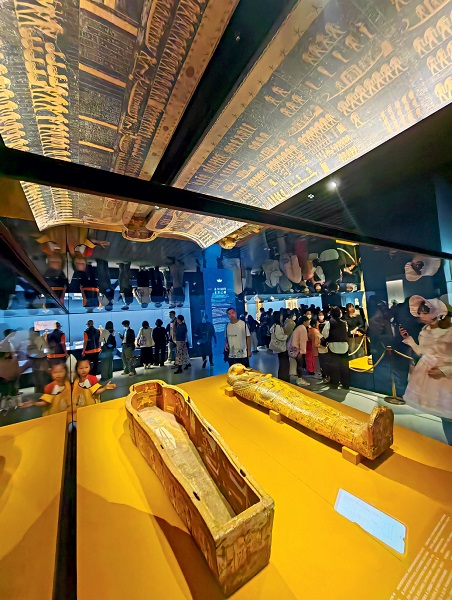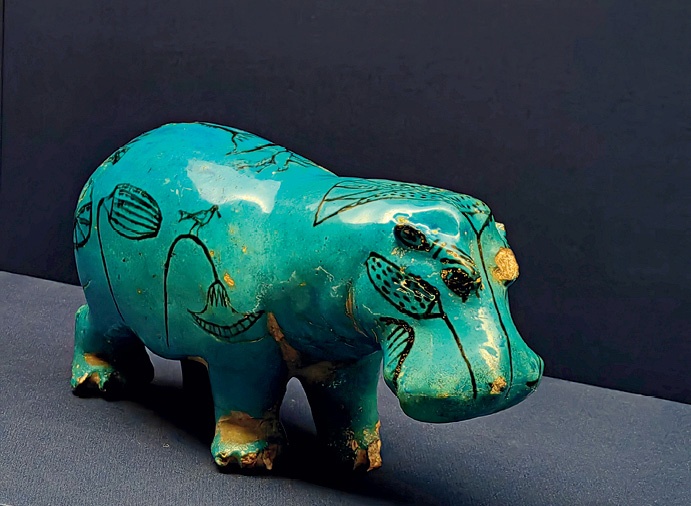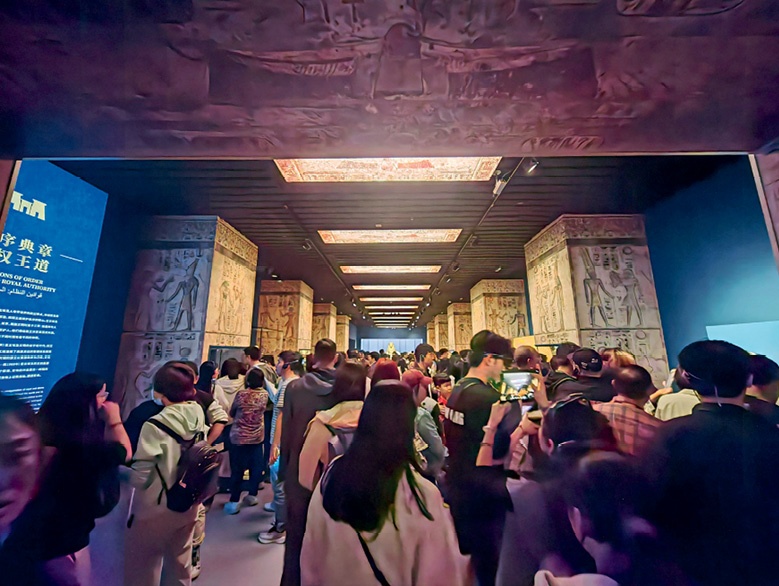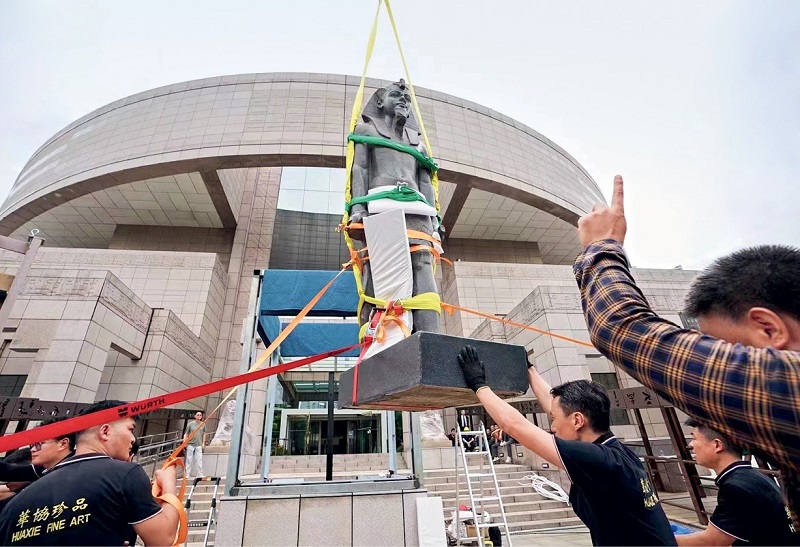The existence of museums is humanity’s stubborn struggle against oblivion. When cultural relics are presented before our eyes, ancient civilizations gain a sense of reality, and people in history become present.

Ancient Egyptian anthropoid coffins typically employed a multi-layered structure, comprised of an outer coffin, an inner coffin, and a mummy board.
On a Sunday morning following this year’s Spring Festival, I accompanied an old friend through “The Land of the Pharaohs” section of the Shanghai Museum’s grand exhibition “On Top of the Pyramid – The Civilization of Ancient Egypt”. The exhibition’s spectacular display included 492 sets of 788 cultural relics spanning three millennia of Egyptian civilization.
These artifacts, meticulously curated from seven premier Egyptian institutions, including the Egyptian Museum in Cairo, Luxor Museum, and Suez National Museum, alongside the latest archaeological discoveries from Saqqara, marked a historic milestone: over 95 percent of them had never before been exhibited in Asia. Together, they unraveled the splendor and mystery of ancient Egypt for Chinese audiences.
Navigating through dense crowds with my friend, memories came flooding back to my mind from my early working days. Freshly graduated in 2014 with a history degree, I started my work at Shanghai’s Jiading Museum, at a time when museums were less frequented by visitors than they are today. Yet recent years have witnessed a cultural revival – museum topics now dominate public discourse, and friends who never frequented galleries now seek my guidance on exhibition tours.

A hippopotamus statuette which ancient Egyptians placed in tombs to assist the deceased in smoothly reaching the blissful afterlife world.
Cultural Heritage Fever on the Rise
My connection with cultural heritage runs deep. Growing up in a dilapidated compound in a Xi’an town, northwest China’s Shaanxi Province, our home occupied the west wing of a two-story tiled dwelling behind its northernmost hall – a crumbling structure of bricks and plaster, weathered by decades of rain and sunshine. Above the main hall hung an inscribed plaque on which were inscribed three ancient characters I later deciphered as zun, jing, and ge – different types of buildings commonly found in Confucian temples and imperial academies to house sacred classics and scholarly works.
My mother often reassured me, “Though humble, this was once Confucius’s dwelling. Children raised here will pass the college entrance exams and have a promising future.” Her words lingered in my mind. Later, when the site was declared a protected building by the local government, we moved out. Later, I finally realized as an adult: my childhood unfolded within a county Confucius Temple.
A decade ago, I would eagerly talk about relics and history, describing the glorious past of my hometown Xi’an as “the capital of 13 dynasties in history” and 72 imperial mausoleums. Meeting foreign visitors, I’d expound on China’s five-millennium-long civilization, introducing precious artifacts. Yet at the time, history and cultural relics rarely sparked much enthusiasm in the majority.
In recent years, Shanghai Museum has significantly facilitated cultural exchange through a dynamic flow of inbound and outbound international exhibitions. While preservation and research form our core mandates, the ultimate purpose remains public engagement. The museum has, over the years, markedly expanded the scope of its special exhibitions.
Behind every special exhibition lies immense unseen effort. Beyond conventional curatorial and design work, major special exhibitions involve the borrowing of artifacts from other museums, which is a sophisticated process.
For example, meticulous condition reporting must be conducted to verify object status and establish safety liabilities, with all findings accurately documented in loan agreements. Prior to shipping and following deinstallation, artifacts require at least dual-layer packing: inner crates (excluding monumental terracotta sculptures) housed within reinforced timber cases. It is all very important that phase-specific safety liabilities be contractually defined throughout the whole process.
Complementing exhibitions, Shanghai Museum has also pioneered multidimensional strategies for engaging audiences. Recent innovations have elevated public participation: the museum has launched digital platforms for doing livestreaming and social media engagement, immersive exhibitions, and cross-sector partnerships, such as limited-edition Year of the Dragon cultural products cobranded with Bright Dairy.
Last July, Shanghai Museum unveiled “On Top of the Pyramid – The Civilization of Ancient Egypt” – marking China’s first official museum collaboration with the Egyptian government. Daily attendance has consistently reached capacity limits since it was opened. “The Land of the Pharaohs” section has been unravelling Egypt’s cosmological visions, social hierarchies, written words, and funerary traditions through a range of artifacts.
“Why were ancient Egyptians so devoted to mummification?” asked my friend.
“To preserve their loved ones’ physical forms,” I explained, “They believed spirits could someday reunite with their bodies. Those portraits on coffins served as visual guides for souls seeking their earthly bodies.”

Visitors crowd the Shanghai Museum’s grand exhibition “On Top of the Pyramid – The Civilization of Ancient Egypt” since it opened last July.
Transparent Restoration Labs
It was afternoon when we stepped out of the exhibition section after the long visit. My friend bought a plush mummy doll from the museum souvenir shop. Watching her radiate childlike delight, I suddenly grasped the profound resonance of cultural creative products: they are archaeology’s symbolic ambassadors, transforming millennium-old mystery into tangible daily joy.
“I don’t remember you ever being interested in museums before,” I said.
“People change,” she laughed, cradling her newly acquired souvenir. “Over the past two years, I’ve become a regular visitor to exhibitions – even delving into history books now.”
That afternoon at Shanghai Museum’s East Wing, we encountered a striking floor-to-ceiling conservation window on the fourth floor. Beyond the glass, conservators were seen delicately restoring cracks invisible to untrained eyes.
“This is a transparent restoration lab,” I said.
Cultural artifacts frequently require restoration due to their deterioration, damage, incompleteness, or decay, aiming to restore their original aesthetic and historical integrity for preservation, exhibition, and academic research. Restoration strictly adheres to the principle of minimal intervention without altering the artifact’s authentic state, avoiding speculative modifications. Due to texture differences, the methods adopted for different cultural relics are also varied.
Many museums now set up transparent restoration labs, allowing museum-goers to observe the daily work of conservators up close. This approach goes beyond static exhibitions to enhance visitor engagement, cultural literacy, and conservation awareness. But to us as museum workers, we deeply know that stringent conservation-grade conditions must always come first.
These practices Shanghai Museum has taken embody President Xi Jinping’s directive to systematically revitalize cultural resources: reanimating palace collections, heritage sites and ancient texts.

Pharaoh Merneptah’s standing statue is exhibited outside the south entrance of Shanghai Museum for public viewing.
Humanity’s Defiant Gesture against Oblivion
My childhood home near the Confucius Temple instilled in me a lifelong interest for relics and history. To preserve artifacts, whether through exhibitions or educational activities, is to safeguard humanity’s collective memory.
This evoked the ruins of Danfeng Gate – the southern entrance to Tang Dynasty’s Daming Palace. As recorded in history books, serving as the emperor’s ceremonial thoroughfare for enthronements, reforms, and pardons, its five parallel passages surpass standard ones of one or three parallel passages – embodying imperial majesty.
Today, only weathered earthen ridges survive – silent witnesses to China’s zenith in history. Beneath a protective canopy, these undulations reveal the gate’s quintuple-avenue structure, kindling modern imaginations of Tang splendor as visitors linger by the ancient passageways, reluctant to depart.
Our guardianship of cultural heritage is humanity’s defiant gesture against oblivion. Should the past be erased, then the present is like a floating weed, losing its anchor and meaning of existence – for today inevitably slips into yesterday. Artifacts are not cold remnants, but living vessels of ancestral wisdom and civilizational codes. When the tangible legacy of human glory fades, guarding cultural relics engraved with information becomes our last duty to maintain historical continuity. 
LIN ZHOU is a staff at Shanghai Museum.